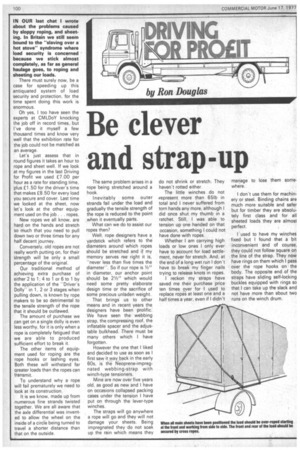Be clever and strap-up
Page 102

If you've noticed an error in this article please click here to report it so we can fix it.
IN OUR last chat I wrote about the problems caused by sloppy roping, and sheeting. In Britain we still seem bound to the "slaving over a hot stove" syndrome where load security is concerned because we stick almost completely, as far as general haulage goes, to roping and sheeting our loads.
There must surely now, be a case for speeding up this antiquated system of load security and protection, for the time spent doing this work is enormous.
Oh yes, I too have seen the experts at CMLDoY knocking the job off in record times, but I've done it myself a few thousand times and know very well that the exhibition rate for the job could not be matched as an average.
Let's just assess that in round figures it takes an hour to rope and sheet well. If we look at my figures in the last Driving for Profit we used £7.00 per hour as a rate for standing time, plus £1.50 for the driver's time that makes £8.50 for every load you secure and cover. Last time we looked at the sheet, now let's look at the other equipment used on the job . . . ropes.
New ropes we all know, are hard on the hands and stretch so much that you need to pull down two or three times for any half decent journey.
Conversely, old ropes are not really worth putting on, for their strength will be only a small percentage of the original.
Our traditional method of achieving extra purchase of either 2 to 1; 4 to 1 or 6 to 1 by the application of the "Driver's Dolly" in 1, 2 or 3 stages when pulling down, is known by rope makers to be so detrimental to the tensile strength of the rope that it should be outlawed.
The amount of purchase we can get on a single dolly is even less worthy, for it is only when a rope is completely fatigued that we are able to produced sufficient effort to break it.
The other items of equipment used for roping are the rope hooks or lashing eyes. Both these will withstand far greater loads than the ropes can transmit.
To understand why a rope will fail prematurely we need to look at its construction.
It is we know, made up from numerous fine strands twisted together. We are all aware that the axle differential was invented to allow the wheel on the inside of a circle being turned to travel a shorter distance than that on the outside. The same problem arises in a rope being stretched around a hook.
Inevitably some outer strands fail under the load and gradually the tensile strength of the rope is reduced to the point when it eventually parts.
What can we do to assist our ropes then?
Well', rope designers have a yardstick which refers to the diameters around which ropes should be stretched and if my memory serves me right it is, "never less than five times the diameter". So if our rope is 1/2"
in diameter, our anchor point should be 21/2" which would need some pretty elaborate design time or the sacrifice of some precious unladen weight.
That brings us to other means and in recent years the designers have been prolific.
We have seen the webbing strap, the compressing roof, the inflatable spacer and the adjustable bulkhead. There must be many others which I have forgotten.
However the one that I liked and decided to use as soon as I first saw it way back in the early 60s, is the Neoprene-impregnated webbing-strap with winch-type tensioners.
Mine are now over five years old, as good as new and I have on occasions collapsed packing cases under the tension I have put on through the lever-type winches.
The straps will go anywhere a rope will go and they will not damage your sheets_ Being impregnated they do not soak up the rain which means they do not shrink or stretch. They haven't rotted either.
The little winches do not 'represent more than 65Ib in total and I never suffered from torn hands any more, although I did once shut my thumb in a ratchet. Still, I was able to tension up one handed on that occasion, something I could not have done with ropes.
Whether I am carrying high loads or low ones I only ever have to account for load settlement, never for stretch. And, at the end of a long wet run I don't have to break my finger nails trying to release knots in ropes.
I reckon my straps have saved me their purchase price ten times_ over for I used to replace ropes at least one and a half times a year, even if I didn't manage to lose them somewhere.
I don't use them for machinery or steel. Binding chains are much more suitable and safer but for timber they are absolutely first class and for all sheeted loads they are almost perfect.
I used to have my winches fixed but I found that a bit inconvenient and of course, they could not follow square on the line of the strap. They now have rings on them which I pass over the rope hooks on the body. The opposite end of the straps have sliding self-locking buckles equipped with rings so that I can take up the slack and not have more than about two runs on the winch drum.












































































































































































